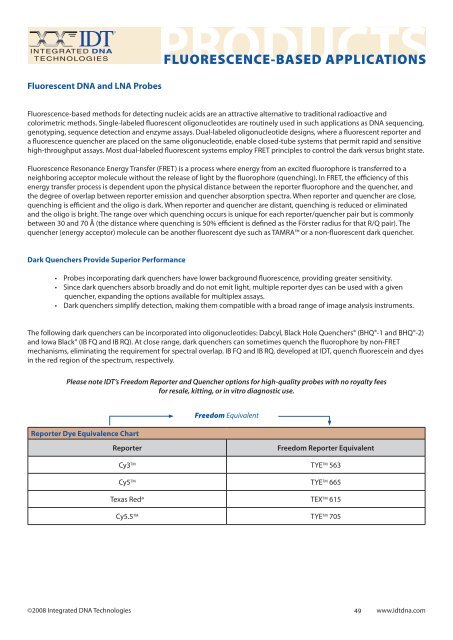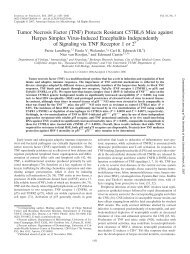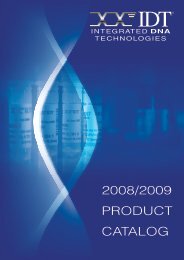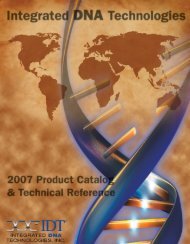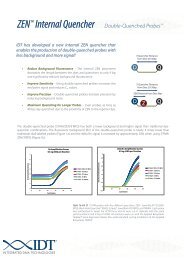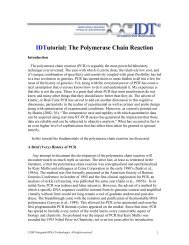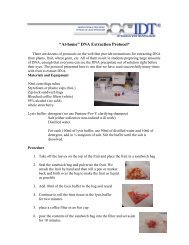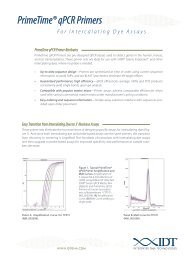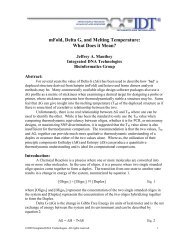products - Integrated DNA Technologies
products - Integrated DNA Technologies
products - Integrated DNA Technologies
You also want an ePaper? Increase the reach of your titles
YUMPU automatically turns print PDFs into web optimized ePapers that Google loves.
INTEGRATED<strong>DNA</strong>TECHNOLOGIESPRODUCTSFLUORESCENCE-BASED APPLICATIONSFluorescent <strong>DNA</strong> and LNA ProbesFluorescence-based methods for detecting nucleic acids are an attractive alternative to traditional radioactive andcolorimetric methods. Single-labeled fluorescent oligonucleotides are routinely used in such applications as <strong>DNA</strong> sequencing,genotyping, sequence detection and enzyme assays. Dual-labeled oligonucleotide designs, where a fluorescent reporter anda fluorescence quencher are placed on the same oligonucleotide, enable closed-tube systems that permit rapid and sensitivehigh-throughput assays. Most dual-labeled fluorescent systems employ FRET principles to control the dark versus bright state.Fluorescence Resonance Energy Transfer (FRET) is a process where energy from an excited fluorophore is transferred to aneighboring acceptor molecule without the release of light by the fluorophore (quenching). In FRET, the efficiency of thisenergy transfer process is dependent upon the physical distance between the reporter fluorophore and the quencher, andthe degree of overlap between reporter emission and quencher absorption spectra. When reporter and quencher are close,quenching is efficient and the oligo is dark. When reporter and quencher are distant, quenching is reduced or eliminatedand the oligo is bright. The range over which quenching occurs is unique for each reporter/quencher pair but is commonlybetween 30 and 70 Å (the distance where quenching is 50% efficient is defined as the Förster radius for that R/Q pair). Thequencher (energy acceptor) molecule can be another fluorescent dye such as TAMRA or a non-fluorescent dark quencher.Dark Quenchers Provide Superior Performance• Probes incorporating dark quenchers have lower background fluorescence, providing greater sensitivity.• Since dark quenchers absorb broadly and do not emit light, multiple reporter dyes can be used with a givenquencher, expanding the options available for multiplex assays.• Dark quenchers simplify detection, making them compatible with a broad range of image analysis instruments.The following dark quenchers can be incorporated into oligonucleotides: Dabcyl, Black Hole Quenchers® (BHQ®-1 and BHQ®-2)and Iowa Black® (IB FQ and IB RQ). At close range, dark quenchers can sometimes quench the fluorophore by non-FRETmechanisms, eliminating the requirement for spectral overlap. IB FQ and IB RQ, developed at IDT, quench fluorescein and dyesin the red region of the spectrum, respectively.Please note IDT’s Freedom Reporter and Quencher options for high-quality probes with no royalty feesfor resale, kitting, or in vitro diagnostic use.Reporter Dye Equivalence ChartFreedom EquivalentReporterFreedom Reporter EquivalentCy3 TM TYE TM 563Cy5 TM TYE TM 665Texas Red® TEX TM 615Cy5.5 TM TYE TM 705©2008 <strong>Integrated</strong> <strong>DNA</strong> <strong>Technologies</strong> www.idtdna.com49


